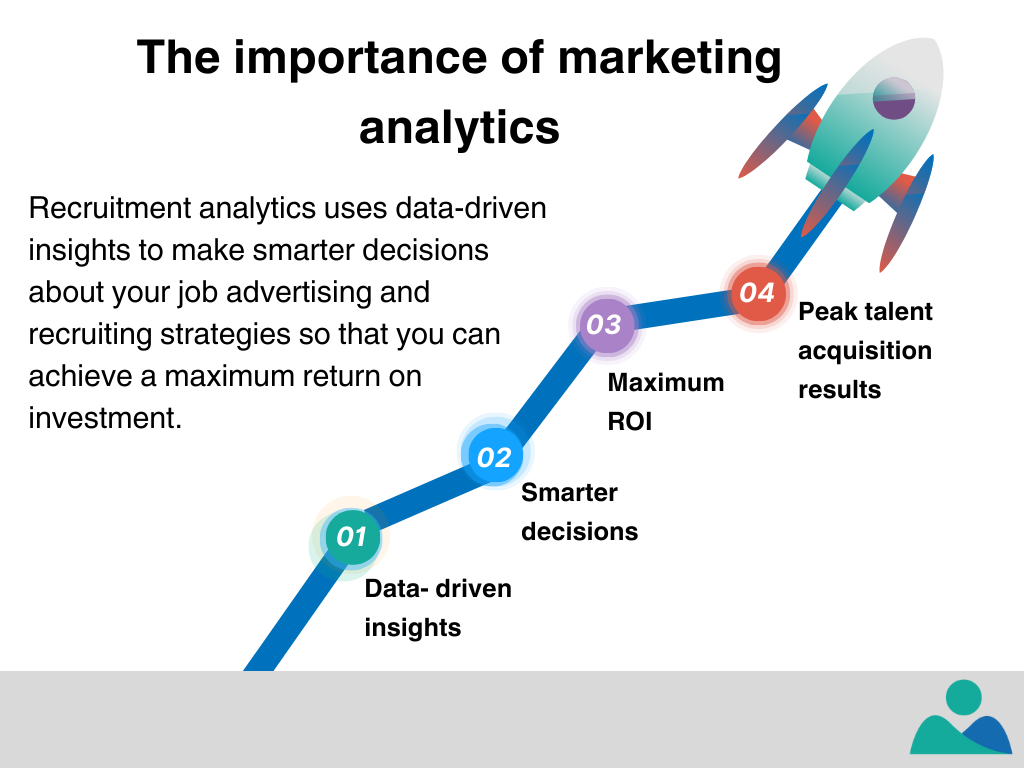Leveraging recruitment marketing analytics helps to gain perspective and optimize your recruitment marketing practices in order to attract the best candidates for a job. Even so, why do HR teams make mistakes?
When it comes to data analysis, the sheer amount of numbers and figures can be overwhelming. To make sense of all this information, you need a narrative with three parts: where your job seekers are coming from (the beginning), their journey while engaging with your brand (the middle), and how many convert at the end (the end). This way, you will have an accurate picture of exactly what’s happening – enabling you to draw meaningful insights that help drive future strategies.
For recruitment marketing teams, this data is essential for making decisions that will impact the recruitment process. With marketing analytics, recruitment marketers can access metrics that show recruitment marketing performance data, response times, and trends. Recruitment teams can therefore understand job seekers’ behavior and preferences and quickly identify recruitment marketing strategies that work best.
In this Article:
What is recruitment analytics and why are they important?
Simply put, recruitment marketing analytics are data points that hiring teams use to understand job seekers’ behavior and engagement trends. It is a form of quantitative analysis that helps measure the effectiveness of your recruitment efforts during the hiring process. These analytics helps the hiring team to understand and target potential job candidates.
As an HR, you should streamline your recruitment journey – from sourcing to selection, hiring, and even post-recruitment retention rate. Let new hires have a positive influence on the success of your business by minimizing turnover levels. Recruitment analytics helps you optimize each step of the recruitment process and track performance over time to ensure that it’s on track with your goals.
To optimize the returns of your job ad investments, evaluating these recruitment marketing analytics is crucial. Here’s why.

Nowadays, it’s almost impossible to escape from the concept of “smart” devices. Whether a smartphone in hand or appliances at home, these items are powered by advanced data analysis and analytics which offer exceptional services and outcomes. Recruitment analytics utilizes data-driven insights to make smarter decisions about your job advertising and recruiting strategies so that you can achieve a maximum return on investment. By leveraging these tools during the recruitment process, you can reach peak talent acquisition results and hit all your hiring objectives.
For your organization to be successful, you must
- Hire the right people cost-effectively
- Make more placements with higher margins
- And drive applicants to specific jobs or companies, while retaining clients.
Understanding the key recruitment marketing metrics
Recruitment marketing analytics is the key to better understanding your talent acquisition efforts and areas that need improvement in your current strategy. The goal is to discover obstacles and areas of recruitment marketing that need improvement. To do so, recruitment teams must analyze recruitment data to identify the key recruitment metrics they should be tracking.
For instance, if new employees leave your business three months after boarding, this may indicate an issue somewhere in your hiring process. This could range from selecting inadequate candidates or not providing effective onboarding opportunities for new hires.
To gain more understanding of how your recruitment funnel affects your business, it is essential to collect as much data as possible. An Applicant Tracking System can give you insights into the recruiting process for new candidates. Performance management software is another great tool to use that provides a timeline for when an employee becomes productive within their team. With this information in hand, you are then ready to begin analyzing metrics that measure success across all areas of recruitment.
HR teams should also utilize employee satisfaction surveys to gain valuable insight into the efficiency of your recruitment and onboarding processes. Once you have collected all of your data, it is time to analyze it in order to devise future strategies for improvement – which we will examine shortly.
Once you have identified key recruitment marketing metrics, it is time to apply those insights to create a more efficient and effective recruitment process.
However, it’s crucial to comprehend exactly how hiring marketing analytics are measured before analyzing these data points through KPIs (Key Performance Indicators). You can accurately distinguish between successful strategies and those needing enhancement within your business operation.
Recruitment marketing KPIs
KPIs, or key performance indicators, are essential recruitment marketing data points that hiring teams use to measure recruitment success. By tracking recruitment KPIs and understanding the recruitment process, recruitment marketers can create more effective recruitment strategies for the future.
It’s essential for the hr team to comprehend how these KPIs are integrated and work together in the full recruitment analytics funnel. At each funnel level, recruitment marketers should focus on two key recruitment marketing metrics: the recruitment marketing spend and recruitment marketing ROI.
By monitoring recruitment spend-to-ROI, recruitment teams can easily identify the most successful recruitment strategies. To understand the recruitment marketing funnel and its associated performance indicators, let’s first look at each step of the process.
Impressions: This recruitment marketing KPI is measured by how many people have seen your recruitment ads (job postings).
Clicks: This recruitment marketing metric measures how many job seekers have clicked on your recruitment ads.
The number of applicants who respond to job ads: This metric is useful for recruitment teams who are focusing on recruitment marketing via job boards. By measuring the recruitment marketing efforts of each board, recruitment teams can identify which boards are the most effective for recruitment.
Job seeker engagement: By tracking how many job seekers engage with recruitment marketing campaigns, recruitment teams can gain insight into recruitment marketing channels that work best for their business.
Time to hire: This recruitment KPI can help recruitment teams understand how long it takes to successfully fill a job. By tracking this recruitment metric, recruitment teams can create recruitment strategies that target top talent faster.
Cost per hire: By measuring recruitment cost-per-hire recruitment teams can determine the recruitment channels and strategies that are most cost-effective.
Analyzing recruitment marketing data
Now that recruitment marketers have a better understanding of recruitment marketing KPIs, it’s time to get into the nitty-gritty and start analyzing recruitment data. Recruitment marketers need to find out who is clicking on job ads, who is applying for jobs, and who is being hired.
Using recruitment analytics tools, recruitment marketers can gain detailed insights into the recruitment process from start to finish. This helps recruitment teams to identify cost-effective recruitment sources and produce high ROI, as well as optimize recruitment channels for maximum efficiency.
Moreover, recruitment analytics can be used to effectively track recruitment marketing expenditure and the associated return on investment. This data gives recruitment marketers the insights they need to make informed recruitment marketing decisions and create an effective recruitment strategy.
How is HR analytics used in recruitment?
HR metrics feed into data analytics that identifies patterns. Repetitive patterns are used in the prediction of future consequences. Meaning recruitment analytics helps recruitment teams to predict future recruitment needs and make decisions based on those predictions.
Recruitment analytics can also be used to track recruitment data points over time to identify trends and optimize recruitment strategies. For instance, recruitment teams can track the recruitment cycle and determine which recruitment sources yield the highest volume of hires in the shortest recruitment period.
Tips to frame your data narrative
1. Look at data as a whole
TA teams routinely make the mistake of having too limited of a perspective. You may have plentiful, timely data, but your efforts will only be worthwhile if you recognize the relationship and invaluable insight between other metrics.
By categorizing and visualizing your insights for evaluation against KPIs, you can bring life back into those numbers. Consider it as an interactive anecdote where you are responsible for optimizing recruitment marketing tactics based on what the story conveys.
2. Set data collection goals
Define recruitment marketing goals that can be measured via recruitment analytics data points. This should include job boards, recruitment marketing channels, recruitment campaigns, recruitment strategies, and job seekers.
By doing this, recruitment teams can create a benchmark of recruitment KPIs against recruitment campaigns and recruitment marketing strategies.
3. Leverage the right tools
With recruitment analytics tools, recruitment teams can collect data from recruitment campaigns and recruitment marketing channels. Organize job seeker-related data from different sources; and analyze recruitment data from recruitment campaigns, job boards, and recruitment sources.
4. Utilize historical and real-time data
Recruitment teams must collect recruitment marketing data from both historical and real-time sources to make the most informed decisions. Historical recruitment analytics data allows recruitment teams to track recruitment KPIs over time, while real-time recruitment marketing data provides more up-to-date recruitment performance metrics.
5. Analyze the Job Ads
Job ads are an essential recruitment marketing tool. Recruitment teams can use recruitment analytics to track the performance of job ads and identify top-performing recruitment channels. By tracking recruitment marketing data from job ads, recruitment teams can optimize recruitment strategies and create more effective recruitment campaigns.
6. Know your Influencers and drivers
When examining your story, it’s critical to recognize the major elements. Most people will home in on the last clicks — when a job applicant made the conversion. But that is comparable to reading only the ending of a book and ignoring everything else. You won’t have an entire understanding of all of the intriguing facts.
Imagine this scenario: In our example below, the “Indeed Paid search link” appears as their “Last Click” right before they finish with their application process – but does that really tell us every crucial detail? Not at all.
Recruitment marketing campaigns can have different influencers and drivers, starting from the initial contact with a potential job applicant. To analyze recruitment campaigns in-depth, recruitment teams need to use recruitment marketing data from job boards, strategies and campaigns, and analytics from recruitment marketing sources.
7. Create a robust recruitment analytics tracking system
Recruitment teams need to establish recruitment analytics tracking systems to analyze recruitment marketing data. This can include recruitment KPIs, recruitment performance metrics, and recruitment marketing strategies.
The most efficient recruitment analytics tracking systems will include recruitment marketing data from job boards, campaigns, and strategies. The most efficient recruitment analytics tracking systems will include recruitment marketing data from job boards, campaigns, and strategies. When recruitment teams collect recruitment analytics data from multiple recruitment sources, it can maximize the success of their recruitment campaigns and marketing strategies.
8. Organize data in a digestible way
Organizing recruitment analytics data in a digestible way is essential to recruitment success. With recruitment analytics, recruitment teams can organize recruitment marketing data into easily digestible recruitment marketing insights. This allows recruitment teams to quickly understand recruitment performance metrics and recruitment KPIs to make informed recruitment decisions, organize talent pools and create recruitment marketing strategies.
9. Review historical data
Analyzing historical recruitment marketing data is also essential to recruitment success. With recruitment analytics, recruitment teams can review recruitment performance metrics from multiple time periods and identify recruitment marketing trends. This helps recruitment teams create marketing strategies tailored to their recruitment goals and maximize recruitment success.
10. Have a Tech Stack that works in harmony
It’s also important for recruitment teams to use analytics tools tailored to their recruitment goals. With the right recruitment tech stack, recruitment teams can quickly and accurately collect recruitment marketing data points and maximize recruitment success.
Essential recruitment marketing tools

Google Analytics
Google Analytics is an essential recruitment analytics tool. Recruitment teams can use Google Analytics to collect recruitment marketing data from job boards, recruitment campaigns, and recruitment strategies. Recruiters can easily find out how many sites are attracting potential applicants to their sites. It’s helpful to check if you get more organic traffic through paid ad campaigns or organic traffic if the person searches for your company or job on the Internet. This information will help you understand which jobs and job advertisements serve you best.
Job Ads Data
Job ads data is also essential recruitment analytics data. Recruitment teams can use job ads data to analyze recruitment performance metrics and create recruitment strategies tailored to their recruitment goals.
Social Platforms
Social platforms can also provide recruitment analytics data. Recruitment teams can use recruitment analytics from social media to analyze recruitment marketing trends, job seekers’ engagement, and recruitment performance metrics.
Data Sources
Finally, recruitment teams need to be able to collect recruitment analytics data from multiple recruitment sources. With recruitment analytics data from multiple recruitment sources, recruitment teams can maximize recruitment success and create recruitment strategies that are tailored to their recruitment goals.
A word from SublimePeople
Recruitment marketing analytics is a tool that every business should be incorporating into its hiring strategy. By understanding the data associated with your recruitment marketing campaign, you can make informed decisions about where to allocate your resources for the greatest impact. With so much potential for improvement, there’s no reason not to give recruitment marketing analytics a try in your next hiring campaign.


